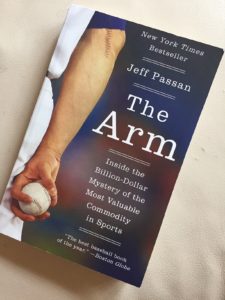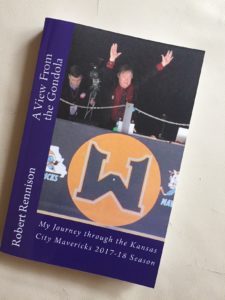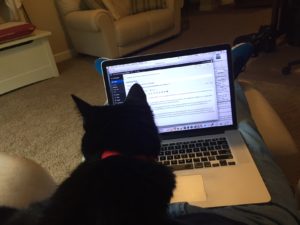The name is Dr. Frank Jobe. Ever heard of him? He was born on July 16, 1925. He passed away on March 6, 2014. He was an orthopedic surgeon. He ended up saving arms and careers.
Baseball pitchers hurt their arms, often in the elbow but also in the shoulder. Why? In my book “Bats, Balls, & Burnouts” I wrote about how the act of throwing a baseball overhand, or even from a 3/4 delivery, is one of the most destructive and unnatural things any athlete can do. The arm was simply not designed to do it. When a pitcher would “blow out his elbow” or feel a pain so debilitating he simply couldn’t throw anymore, his career was typically over. Just ask Sandy Koufax, who was the most dominating pitcher in baseball and at the top of his game at the young age of 30, until his elbow began to ache so badly he’d have to sit in the clubhouse with his left elbow dunked in a bucket of ice and water after each game, just to numb the pain and give him a chance to pitch again a few days later. At the age of 30 he was done, thanks to ligament damage and arthritis. No one knew how to make the pain go away.
In 1974, another pitcher for the Dodgers, by the name of Tommy John, “blew out his elbow” like so many others before. He consulted with Dr. Jobe who diagnosed the injury as a torn ulnar collateral ligament (UCL), the ligament that basically holds the elbow together. Up until that point, tearing the UCL had never produced an outcome other than continued severe pain and, eventually, the end of a pitching career. Dr. Jobe, though, had a radical idea. Tommy John was the first pitcher to have the procedure done. Dr. Jobe took a tendon out of John’s right arm (he was a left-handed pitcher) and transplanted it into John’s left elbow. He was so unsure of how successful the outcome would be Dr. Jobe didn’t try it again for two years. The doctor wanted to see if it would work, and Tommy John would need those two years to find out.

Tommy John had pitched 12 years in the Big Leagues. The surgery seemed a far-fetched idea, and it likely wouldn’t work. Dr. Jobe himself gave it a 1 percent chance of success. It worked. After rehab, Tommy John pitched an astonishing 14 more seasons in the Big Leagues. Today, an ulnar collateral ligament replacement is simply known as Tommy John surgery, and in about 85% of the cases, the pitchers come back as good, or even better, than they were before the injury.
I’ve received two books in the mail this week, and the one to the right here just came today. Reading it will be a key piece of research for my upcoming book. I don’t want to divulge details, but once the book is out you’ll understand.
When I pitched in the Oakland A’s farm system, as a reliever, I threw side-arm and submarine. Not because I was so smart I knew throwing as hard as I could overhand was a bad idea, but because I didn’t have very good command doing it the conventional way. Throwing from the side or down below, I could hit almost any spot the catcher gave me.
I don’t have many regrets in life, but one I do have is the fact I didn’t know how good I could be on the mound until I was 23 and basically a washed-up outfielder. Had I tried it earlier, I definitely would’ve stayed with the delivery I used during that summer in Medford. And my elbow would’ve thanked me for that.
Even as a high school outfielder, I can remember my mom driving while I was sitting in the passenger seat of our Impala as a freshman or sophomore, during spring when baseball was in season. It was all I could do to keep from crying. I rode home in that car feeling my right elbow throb with a pain that was almost unbearable. It felt like the worst toothache you ever had, combined with the worst sprained ankle, all focused on one small spot in my elbow. I never told my parents or anyone else about it, because I was afraid they’d make me quit. And all I knew to do was “play through it.” It would usually go away after a few weeks, because it was just strained and not torn. I was lucky. In the end, my shoulder was worse than my elbow. Years later, when I was in my 30s and playing for the Sauget Wizards, I saw a specialist for the shoulder. His diagnosis was severe tendonitis and most likely a partial tear in my rotator cuff. He said, “You have two options. The first one is surgery. You’ll have a year of really painful rehab and the symptoms could come right back. The second option is to stop throwing things. If you do that, your arm won’t hurt too bad just doing everyday activities. But, any time you throw anything it’s going to hurt and any one of those throws can be the one that tears your rotator cuff. Once it’s torn, the first option is all you’ll have left.”
Because I’m a lousy patient, I played three more years and it always hurt. To this day, if I succumb to the temptation and throw something, an invisible knife seems to be jabbed into my shoulder. Baseball, like many sports, can leave its mark on you for a long long time.

The second book I received this week is this one, and if you read “Bats, Balls, & Burnouts” you’ll be familiar with the author. Bob Rennison was my radio play-by-play announcer for the Kansas City Attack indoor soccer team. I picked his audition tape as the best in a stack I had on my desk. It was his first professional play-by-play job. He’s still doing it, 24 years later, and is now the voice of the Kansas City Mavericks minor league hockey team.
Bob and I have stayed in touch, and he often calls me for advice when he’s not sure about a decision he has to make. When I was writing my first book he called and told me that he wanted to write a book, too, but he wasn’t sure how to get started. My advice was “Why don’t you do a daily diary of the full Mavericks season, telling all the stories about the guys, road trips, the fans, and your family?” That’s exactly what he did, and his book just came out.
The title of Bob’s book is “A View From The Gondola” and that’s a reference to where his broadcast position is, high up in the rafters at the Mavericks’ arena in Independence, Mo.
Early in the book, he wrote these kind words, after first mentioning the fact that in 1994 he had given up on his dream of being the radio guy for a professional sports team:
“My career was resurrected the day I received a phone call from Bob Wilber, as he left a message asking me to be ‘the voice’ of the Kansas City Attack. In 1994 I decided to give up on broadcasting for a professional team and find a small town radio station to stay with forever. I sent my resume and audition tape to Bob, shortly after he became general manager of the Attack, but decided not to give him a follow-up call. After arriving at Kauffman Stadium to take tickets at a Royals game, I called Abbie on a pay phone and she played the message from Bob on our answering machine.
“I believe from time to time God intervenes in our lives. The call I received from Bob Wilber was one of those occasions. Had he not contacted me I don’t know what I would be doing now, but I would have fewer friends and would not be as happy as I am today.”
I’m honored Bob wrote that about me, but he gets all the credit. When I heard his tape, my first thought was “This is the guy. This is my announcer” and it was one of those rare occasions when I got it absolutely 100% right. He was the guy. I had no idea he’d never been a play-by-play guy for any professional sports team. I just knew he was good. Congratulations Bob! You’re an author now, and I can’t wait to read the rest of your book.
And here’s a coincidence that’s semi uncanny. When we lived next door to Neighbor Dave and Nichol, their daughter Alexa was still big into hockey, first at Woodbury High and then at St. Norbert College near Green Bay. Concussions ended her playing career, but she ended up meeting a guy named C.J. Eick, who played for the Green Bay Gamblers junior hockey team. That was years ago, but their relationship sure looks like one that’s going to last forever, and they’ve just packed up for the winter to go live where C.J. plays professional minor league hockey. He plays for the Kansas City Mavericks, and Bob Rennison is the guy who calls out his name on the radio every time he touches the puck. Small world.
So, let’s move on to some Q & A… A couple of these came in as emails over the last few weeks, but the first one came this past Monday and it gave me the idea to post a few more.
Cynthia, from my home town of St. Louis, has been reading my blog “since Day 1” as she put it. She actually lives in Creve Coeur, a suburb only a few miles from where I grew up in Kirkwood. She, somewhat tongue in cheek, sent me this:
“OK, so you’re a St. Louis native and your dad played for the Cardinals. Why aren’t you writing about them in your blog? It’s all about the Twins when you write about ballgames. I’m only kidding, and I know you’re a big Twins fan, but give some love to the Redbirds! Go Cardinals!!! And hey, I love your blog even with the Twins stuff.”
I wrote her back and said, “I’ll always have a ton of love for the Cardinals, but I haven’t lived in St. Louis since 1994 and only get to see them on TV a few times a year. Most of what I absorb as news about the Cardinals comes from Facebook posts by all my St. Louis friends and former classmates. I’ve actually only been to the new ballpark twice! It’s just hard to follow them and feel a connection from this far away, when I know so little about the players, but there will always be a good deal of Cardinal red in my bloodstream. Go Cardinals!!!”
Sadly, since I replied to her the Cards have lost three big games in a row and have played themselves pretty much to the precipice of not making the playoffs as a Wild Card team. I’m a jinx.

Side note: It’s really hard to write a blog when Buster demands he take his place on my lap. I can hardly see the keyboard. He’s a good boy.
OK, back to a couple more questions…
Terry, from Enid, Oklahoma wrote:
“For a guy in his 60s, you have some really interesting taste in music. We seem to like a lot of the same stuff, and I’m just 36. I know you have Sirius XM in your car and you wrote about that in your book. Any new bands out there you really like? I’m always searching for new stuff.”
Cool question, and yes I do have some favorites I hear on the Octane channel. A band called Greta Van Fleet will absolutely spook you when you hear them. They are Led Zeppelin all over again, but the crazy thing is they are all really young, as in early 20s or younger. Three of the four guys are brothers (two of them being twins) and they channel music that just doesn’t get written and played like this anymore. Until they came along.
I’m big into Breaking Benjamin, Bring Me The Horizon, and a band called Thrice. I’m big into a lot of stuff, but rarely leave it on Octane if a song comes on by one of those bands that feature a “singer” who just screams. The channel gets changed immediately when that junk comes on. Give me some Evanescence, Shinedown, Avenged Sevenfold, Skillet, Chevelle, and stuff like that. But hey, music is like food. We all have different tastes.
Finally, Jimmy from Lakewood, Colorado asked this.
“I know you love Bandimere Speedway, but I have a question. When I first started going there in the early 90s, it seemed like the difference between how the nitro cars ran everywhere else versus Thunder Mountain was huge. These days it’s still a little slower but not nearly as much. How did that happen?”
Another great question. Answer No. 1 is the fact that crew chiefs are really (like REALLY) smart. They learn how to go fast and they’ve done a great job of adapting to the mountain. Answer No. 2 is at the starting line. Bandimere used to present teams with a total double-whammy. It’s usually hot there (sometimes it’s sizzling) so you had bad air made worse by high altitude and that made it really tough to get enough traction early in a run in order for the aerodynamics to help with downforce. When they put the totally unique cooling system in, stretching 345 feet beginning behind the starting line, it dropped the temperature in that early part of the track by up to 25 degrees. That really helps the cars get off the line and up to speed. Now, the challenge is getting through the transition where the cooling system ends, but that’s on the crew chiefs. And remember, they’re smart. Really smart.
So that’s about it for today. The UPS guy just plopped a box down on our porch upstairs and both boyz did the low grumble before they took off on a sprint to see what was going on up there. I’m lucky I don’t need stitches after Buster used my left thigh as his launch pad. Those claws left a mark…
As always, if you read this installment and thought “That wasn’t a TOTAL waste of my time” please hit the “Like” button at the top. A few more likes and I get to spend 30 days on the International Space Station. That last part may or may not be true, but still…
Bob Wilber, at your service and ready to read two new books.